Berrybun
Appearence

BASICS
About
Berrybun are mammals that can produce Gouberry in their body and live wandering the fields of Laetus. A Berrybun's appearance resembles that of a large rabbit with a leafy coat, and an adult Berrybun can reach up to 1.55 meters in height. They are not aggressive and do not mind if someone picks their fruit, as long as they do not scrape the roots of their fur as it hurts. They tend to flock and the taste of the Gouberry may vary depending on where the Berrybun lives.
Eyrolin
Appearence
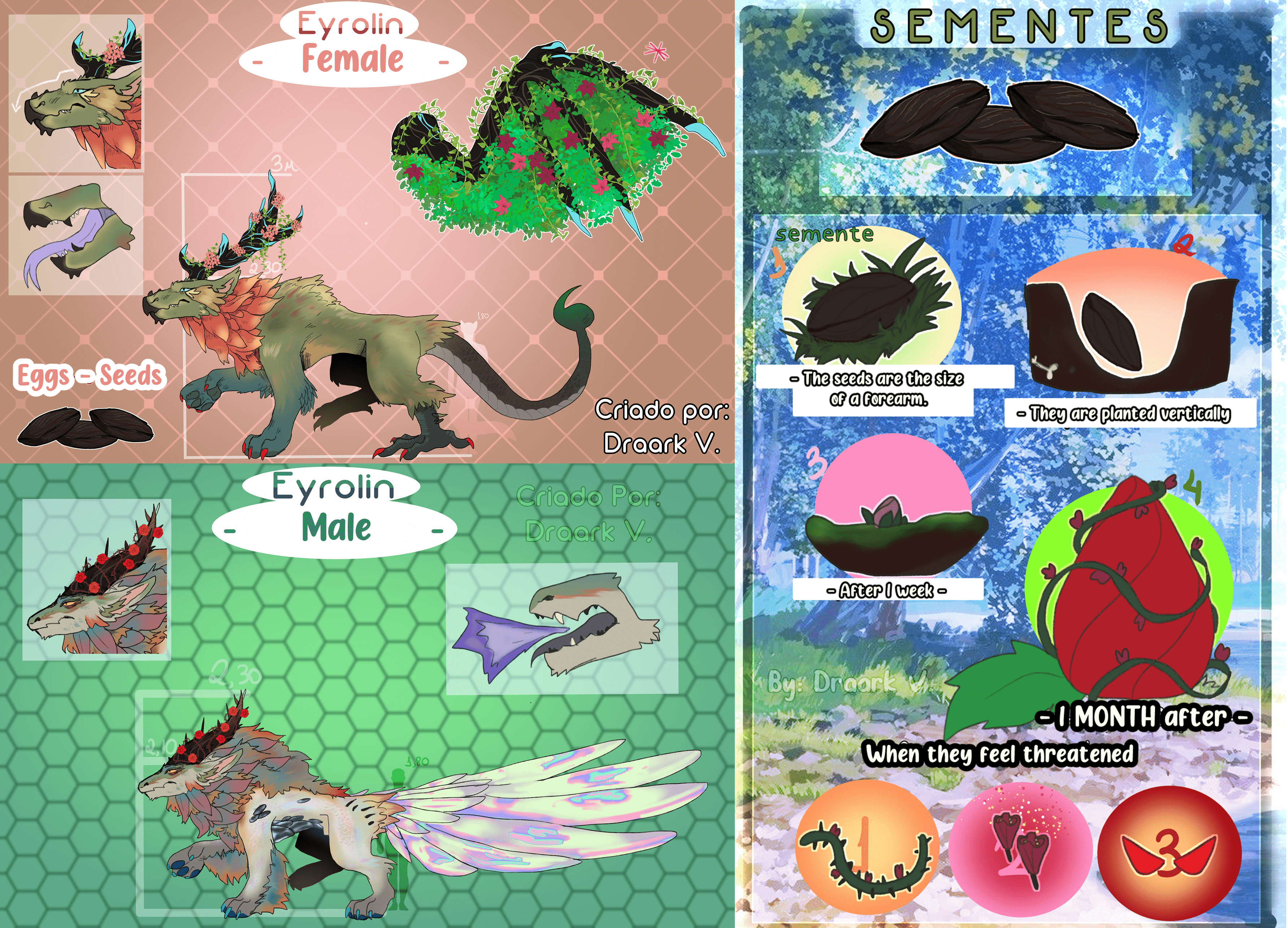
BASICS
About
Eyrolins are dimorphic animals that live deep in the Laemon Forest. When they feel threatened, the thorny vines go on alert, and if the creature is within 5 meters of it. It has small flowers that are easy to pluck but difficult at the same time. They have a poison that immobilizes the creature and can even cause it to faint. The small flowers are responsible for calling the mother. They release their scent to warn of danger. After that, they close. Females have flowers that don't have thorns, rarely the other way around, and males have flowers that do have thorns. They can be domesticated (although it's quite difficult).
Female Eyrolins: Female Eyrolins are larger than males, and have a "wilder" coat with natural dark colors. They have a "mane" made of leaves, and inside it, they have small spines and an extremely dangerous scorpion tail. Their snout is more rectangular and has a beak at its tip. Its front paws are lion paws, and its back paws are water paws to catch its prey. Its horns are quite large and have flowers, and can often get different flowers each season. The flowers have no thorns, they have hair, and their tail has scales. They have wings that are made of very strong wood and are difficult to cut.
Generally, female Eyrolins are much more aggressive than the males, they are the ones who dominate when it comes to mating. They choose their mate, choosing the one who is ideal for them, they have this requirement to have strong offspring. Female Eyrolins stay with only one partner all their lives, and even though it is rare, it is possible for them to go in search of another. Females have the ability to grow wings from shoots hidden in the hair on their back, usually used for nest defense or hunting. Eyrolins live between 100 and 120 years and are 3 meters tall.
Male Eyrolins: Males have the head with a more circular snout, their horns are large, thick, and have thorns and roses, and they have large ears. The hair on their necks has leaves and some thorns, and their mane hides a large part of them, all the way to their tails. Its body has shiny scales and hair, especially its tail feathers, which are very shiny. The scales on their body are resistant to any kind of weapon.
They are more aggressive when they are close to their territory. Other than that, just don't stand in their way or get in their way, and they won't attack you. Their main role is to defend the group and their territory, any kind of intruder they will attack by spitting their fire. The males release a fire (called Vita Translatio) in which its role is to burn its target, and then it turns into organic matter for the soil. You don't necessarily need a living being there, but their own fire already saves a dead/no nutrient soil. Even though they are smaller than females, they are very careful with their partners. Male Eyrolins live between 110 and 150 years, and measure 2.30 meters.
Nest: Eyrolins lay eggs via seeds, which are planted vertically. The seeds are the size of an adult florus' forearm, after one week a sprout is born, and from then on, it grows bigger in up to one month. The nests have strong roots and a strong smell to keep predators away. Up to 3 young can be born, and the nests are larger than both humans and florus (3 meters). When the nest is threatened, a strong-smelling substance is released into the air to alert the female of the danger. If the female feels that infertile soil is the best place to plant her seeds, she may ask the male to use Vita Translatio, to leave the soil in a good state.
Niblur
Appearence
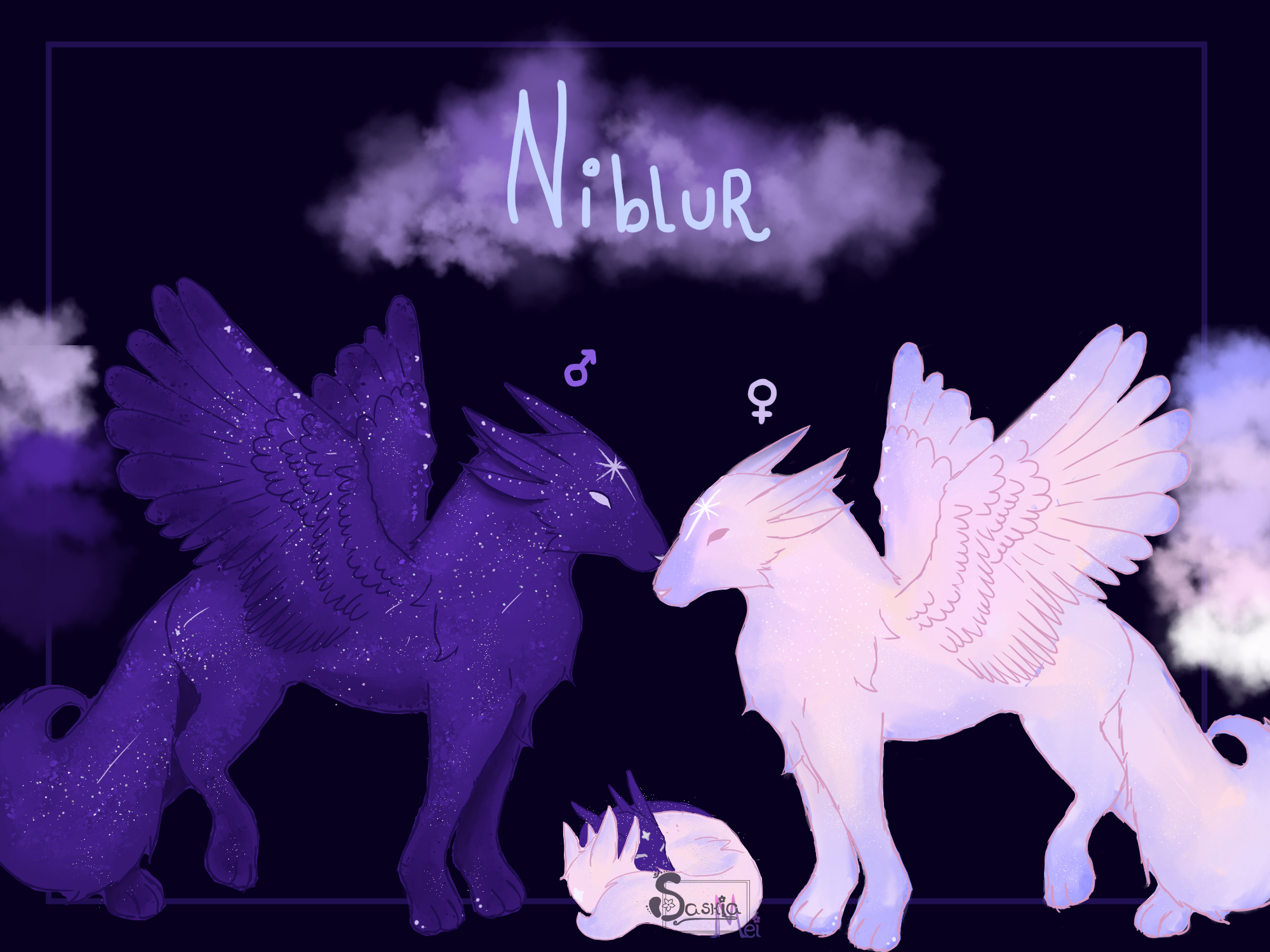
BASICS
About
Niblurs are mammals with dimorphism that feed on fruits and fish. A male Niblur measures between 3 and 3.5 meters, has a purple fur, and is starry. A female Niblur measures between 2.5 and 3 meters, has a pinkish coat with some shades of lilac, also with some stars all over her body.
Both have wings and can fly, they spend most of their time flying in Laetus and hiding in clouds, it is quite rare to find one around. Legend has it that it is possible to find a male Niblur at dawn, near waterfalls. Another legend says that there is a large group of Niblurs that live in the Lazulie Forest. No trace has ever been found in this forest, but a long time ago, a florus exploring the Laemon Forest found a Niblur there, which seemed to be lost. According to this florus, the Niblur got scared and flew away, never to appear there again.
It is practically impossible to tame a Niblur, since it is a rare animal. But the God Aladus has a couple.
Popuni
Appearence
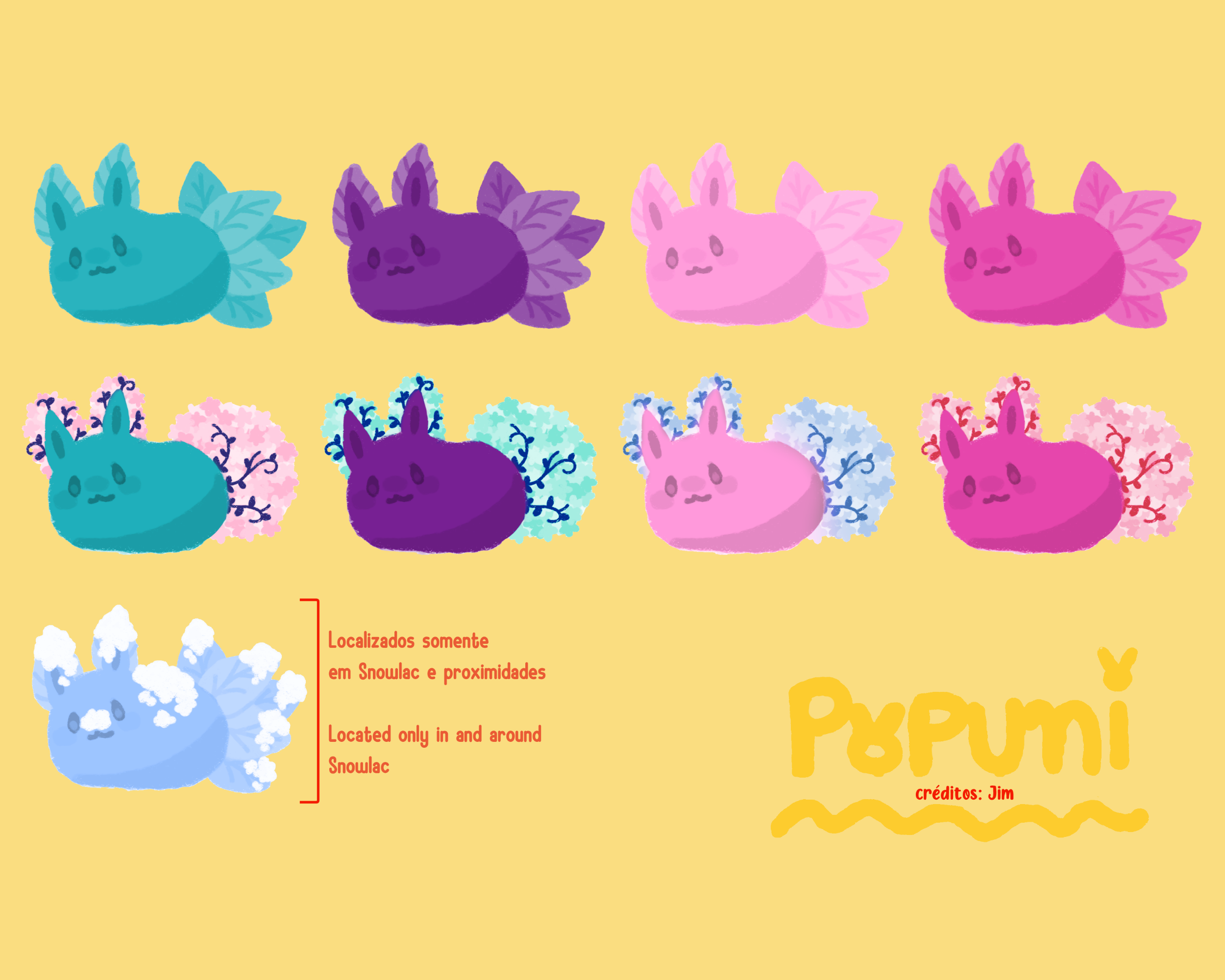
BASICS
About
Popunis are quite Yesilar to rabbits, but made of leaves. The color of their body varies, depending on which tree the Popuni was born from. They are quite small, 6cm high and 12cm wide. They are born through the trees, when the leaf falls, the leaf mixes with the grass and the earth and a Popuni is created. They live on tree trunks. They feed on soil and seeds of watermelon and passion fruit, and can absorb moisture from the soil and stay hydrated. They can camouflage themselves easily in grass and trees, be careful when stepping around, you might step on and hurt a Popuni!
They can die if their leaves are torn off, they are part of him and it hurts any removal of the leaves. They are cute and docile, but they are quite risky, Popunis have emdos of larger species (including the florus). They can be domesticated, but it is quite difficult, requires a lot of patience and watermelon and passion fruit seeds.
As said before, the color of a Popuni can vary depending on the location, but only in Snowlac can the Popuni have a light blue color and always be covered with snow. Every 3 months, its leaves are in bloom for 1 whole month, and the color of the flowers is quite varied as well. Even though the Popunis are skittish, they are used in Bloom Farm, as they help fight farm pests that try to destroy the crops. There is no animal mistreatment with the Popunis at the farm!
Ophidia Floridus
Appearence
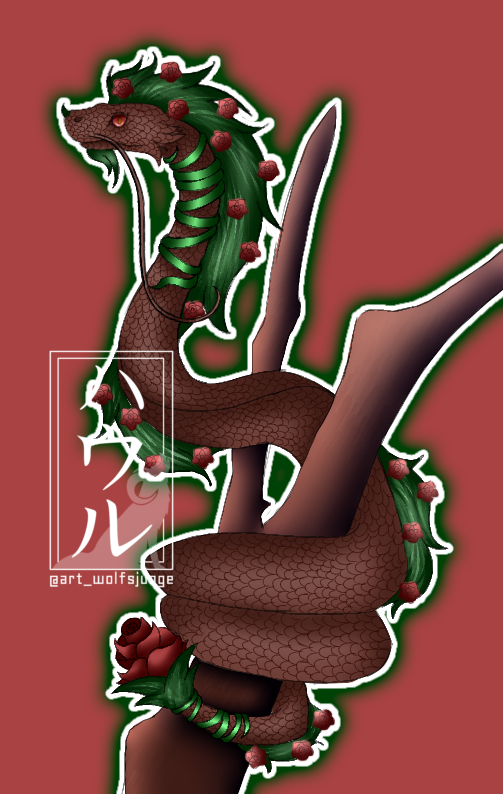
BASICS
About
Known as the Mustache Snake, the Ophidia Floridus are master animals in camouflaging themselves in nature, their colors and flowers varying according to the place they were born, as they live scattered all over Laetus. Whiskered Snakes can adapt to any environment and climate, and can also be found in lakes and rivers. Their diet varies according to the place they live and their reproduction is sexual; during the mating season, the males become more aggressive and the females choose the one that is stronger than the others, to ensure strong offspring in the future. They are born through eggs.
The temperament of Mustache Snakes varies widely. Each one has its own personality, some are more aggressive than others or even affectionate than others. In this way, it is possible to domesticate and many are even pets of other florus. The more aggressive ones live in caves, have a grayish coloration and vibrant flowers to camouflage themselves amidst precise stones.
The size varies from 1 meter to 3 meters long, depends on the place where they were born, because they need to camouflage themselves to the environment, the longest and most aggressive live in the Laemon Forest. The size of the aquatic species depends on how deep the place where it was born is, the deeper it is, the bigger it will be. There is a legend by fishermen about the existence of an Ophidia that measures 10 meters long.
Ophidias hide their retractable poisonous spines in their tails, which are usually used by males during duels, and females use as defense. The venom is used in the study of medicines and alchemy. Their variety is so extensive that many have their own flowers on their feathers and tails, and several species of rose can grow on a single Ophida Floridus. The marine species can produce algae. Their flowers exude a perfume that is immensely fragrant, and many are used in perfume making, where they extract the flowers from their plumes. Even if you cut one of its flowers, it will grow back, and the process thankfully involves no pain.
Sawakura
Appearence
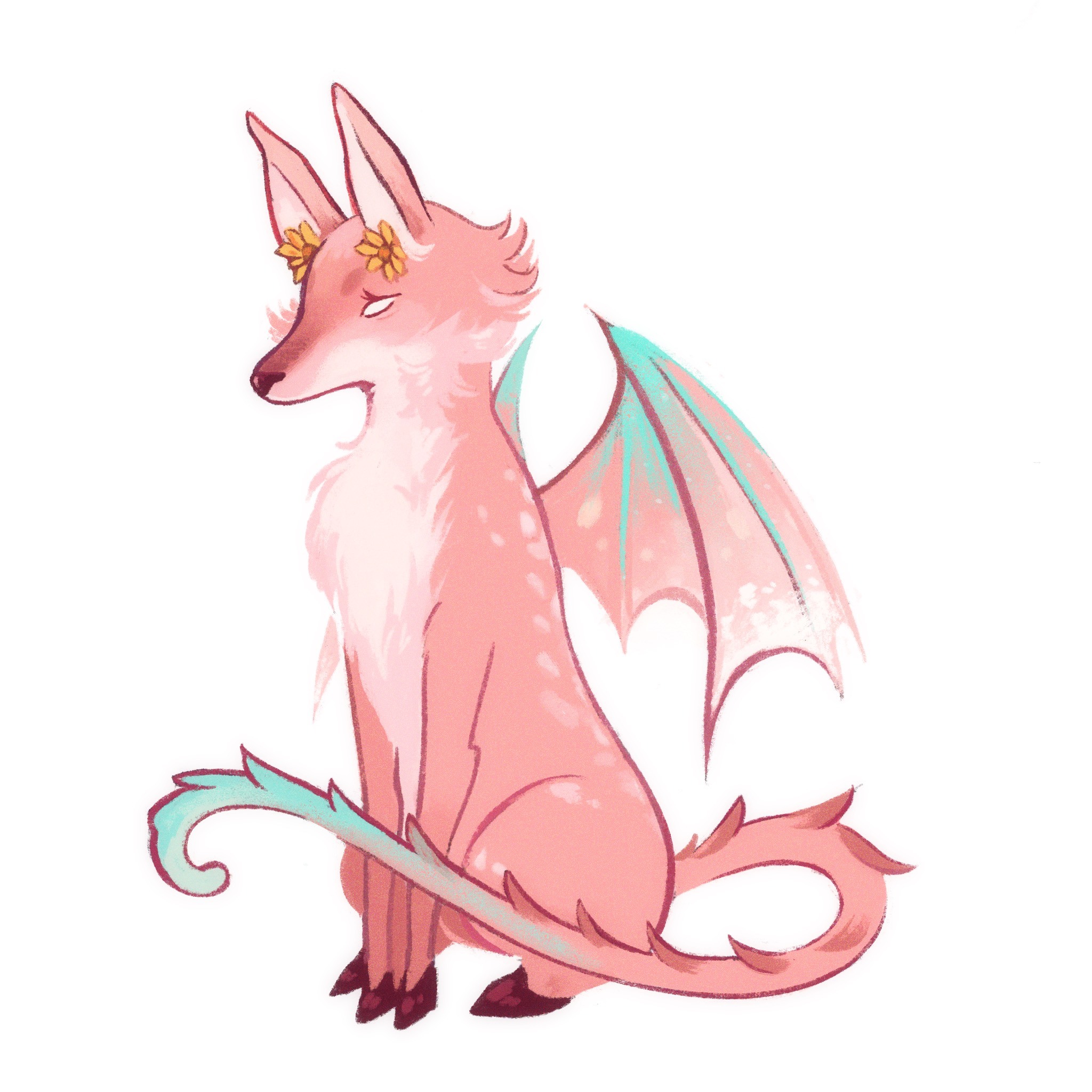
BASICS
About
Sawakura is a delicate fox with modified ears and paws, living in the fields of Laetus. It can fly with its slightly translucent wings and hides its food very well. Sawakura is a very common animal in Laetus that doesn't bother anyone - unless they got bothered.
In the cold months, they usually show up less. They are hiding for warmth in caves, or breeding.
Jelly Cat
Appearence
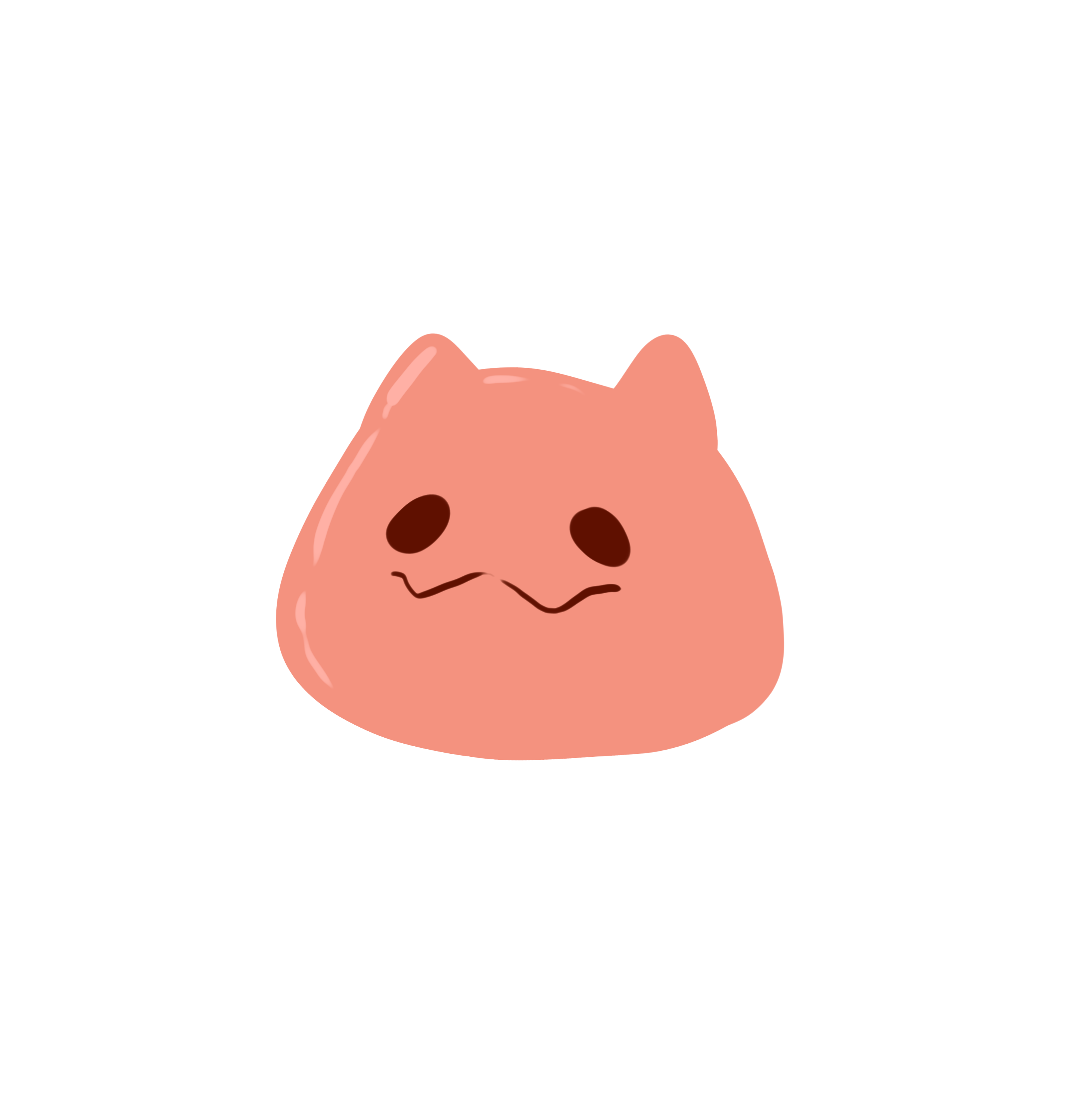
BASICS
About
The Jellycat is a creature that resembles a jelly or slime. It is an animal that is not aggressive and likes to steal food from others, it is very, very hungry. The more it eats, the more it grows, it can reach up to 1.50 meters, but it is very rare. The most common thing is that they are very small. They can multiply easily and this is their way of reproducing.
Hanaeru
Appearence
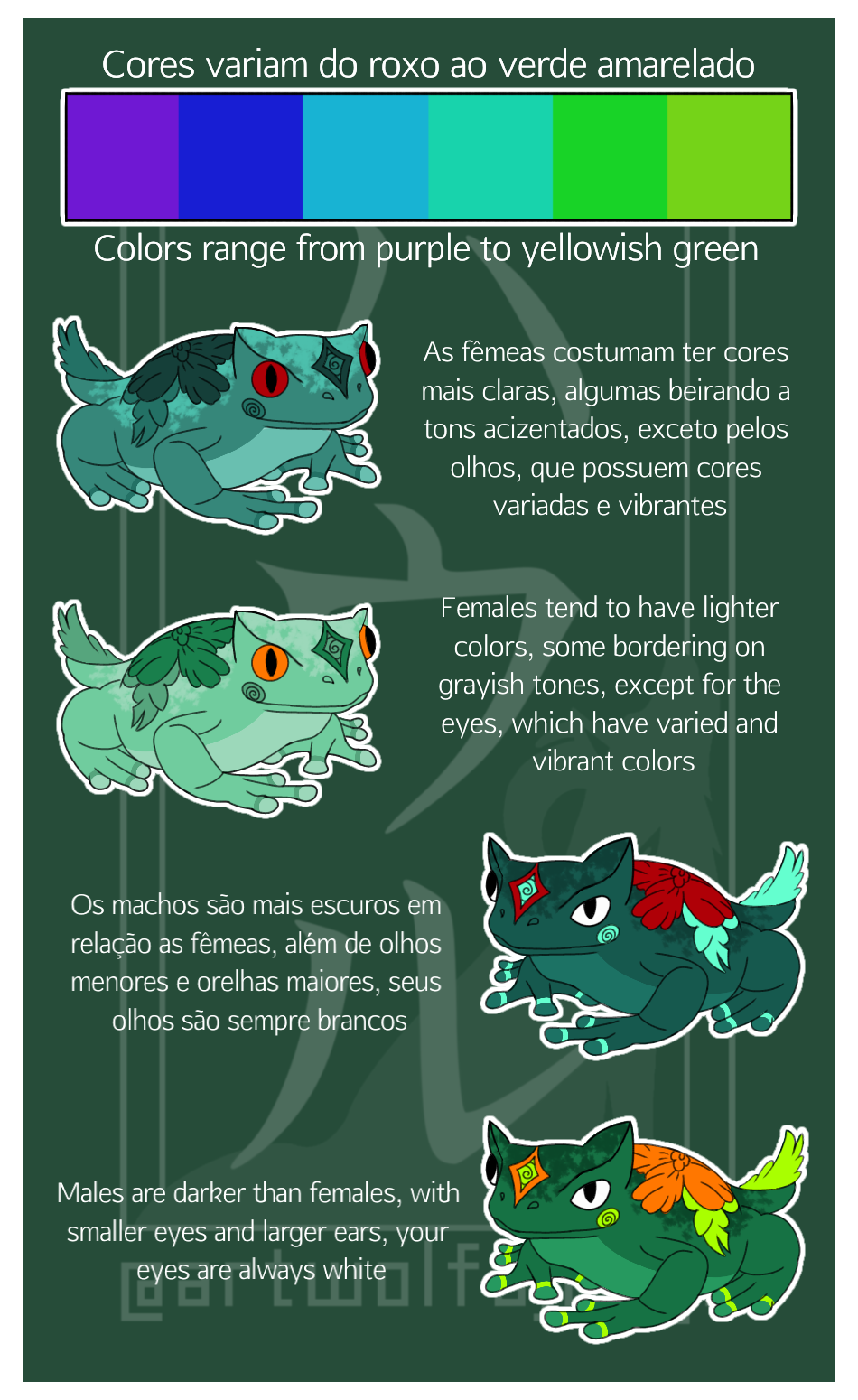
BASICS
About
Hanaeru are small amphibians with dimorphism, resembling frogs. Females have roses in the same shade as their skin, only darker, while males have them in gray tones until they go through the first mating period, where the roses acquire colorful shades imitating the same shade of the eyes of the chosen female, as a way to attract her attention and show her love. On the male's back he has leaves with vibrant colors, to warn predators that they have poison. The venom spat at predators makes them blind, but it is harmless in Florus and can even be used for medicine. They are monogamous animals, so they have only one partner for life, and are extremely familiar and loving.
The growth cycle is similar to of frogs in the human world, the only difference being that their eggs look like small aquatic flowers, to camouflage themselves and avoid predators. The males play the role of protecting their child while the mothers go out in search of food, and their family bond is so strong that losing their mate or young can cause them deep anguish and isolation, as they stop eating in an effort to join their loved ones. It is not recommended to breed only one of the species, because they are animals that need the contact and company of another, regardless of sex, and it is not uncommon to have male or female pairs, which play an important role for the species due to their peculiar behavior of adopting eggs whose parents have died. Male pairs have white roses on their backs, just like their eyes.
Faefly
Appearence
BASICS
About
The Faefly is a very common insect in Laetus, varying in color. They appear all year round except in winter - only the blue ones appear in cold weather. It has a habit of staying on top of flowers to get the nectar from the flower, and sometimes even lands on Florus to get the nectar from his flowers. Flaeflies have glass wings, which anyone can remove the wing of a Flaefly and eat, and have a sweet, watery taste.
Meonbee
Appearence
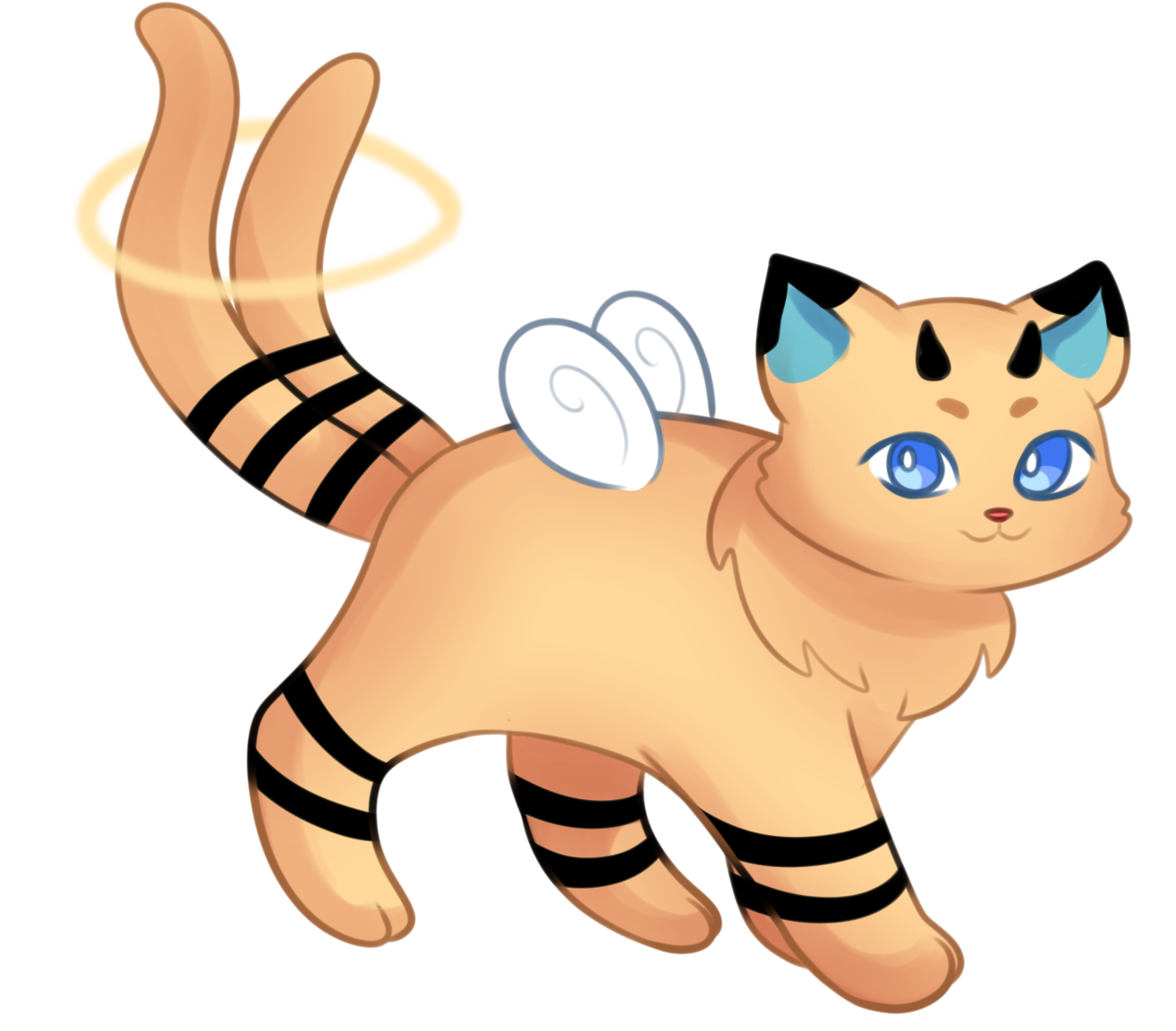
BASICS
About
A feline with wings, two tails and horns. Also with a halo on both tails. Meonbee is a creature that, even with its wings, does not fly very high. It is about the size of a standard cat and does not grow much, its fur is usually shades of orange, yellow and red. They breed normally.
Chocolapin
Appearence
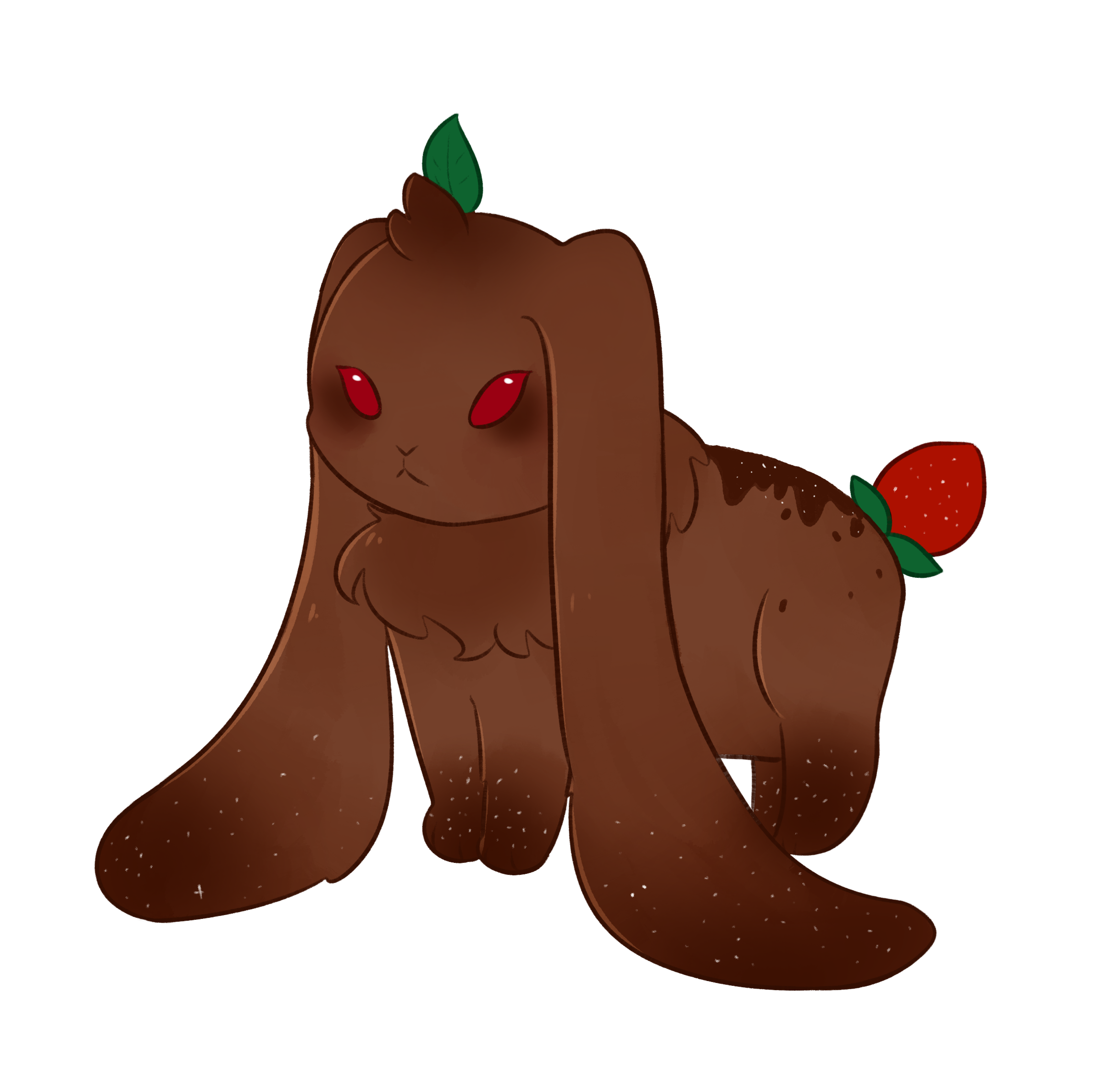
BASICS
About
An adorable rodent that resembles a rabbit, with the body of a cat. They are relatively small, growing to a maximum of 30cm. They get restless at easter time, as they love lots of chocolate. They have a little habit of stealing things and burying them in the ground, usually shiny objects or food, especially chocolate.
Berrybun
Aparência

BASICS
Sobre
Berrybun são mamíferos que conseguem produzir Gouberry em seu corpo e vivem vagando pelos campos de Laetus. A aparência de um Berrybun lembra a de um coelho grande com a pelagem de folhas, e um Berrybun adulto consegue chegar em até 1,55 metros de altura. Eles não são agressivos e não se incomodam caso alguém pegue as frutas, desde que não raspem as raízes de sua pelagem, já que machuca. Eles costumam andar em rebanhos e o gosto da Gouberry pode variar dependendo do local que o Berrybun vive.
Eyrolin
Aparência
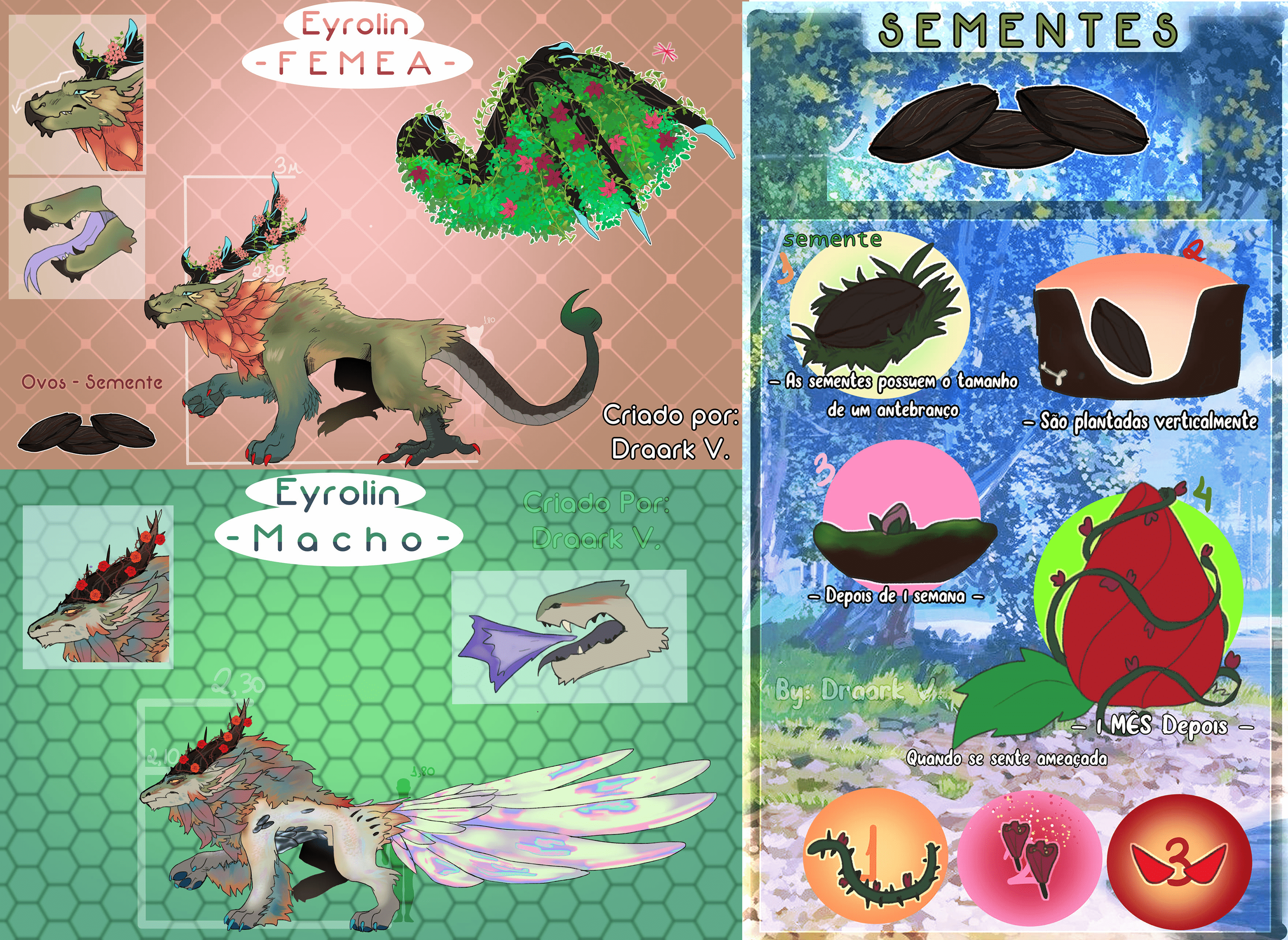
BASICS
Sobre
Eyrolins são animais com dimorfismo, que vivem na profundidade da Floresta de Laemon. Quando se sentem ameaçados, as vinhas espinhosas entram em alerta e, se a criatura estiver próximo até 5 metros dele. Possui pequenas flores fáceis de arrancas mas ao mesmo tempo difícil. Possuem um veneno que deixa o ser imobilizado e pode até desmaiar, e podem prender o ser vivo. As flores pequenas são responsáveis por chamar a mãe. São elas quem soltam o cheiro para alertar o perigo. Após isso, elas se fecham. As fêmeas possuem flores que não tem espinhos, raramente é o contrário, e os machos possuem flores que tem espinhos. Podem ser domesticados (mesmo sendo bastante difícil).
Eyrolins fêmeas: As Eyrolins fêmeas são maiores que os machos, possuindo uma pelagem mais "selvagem" e com cores escuras e naturais. Possuem uma "juba" feita de folhas e por dentros delas, tem pequenos espinhos e, um rabo de escorpião extremamente perigosa. Seu focinho é mais retangular e possui um bico em sua ponta. Patas fronteiras são de leão e atrás são patas de águas para pegar suas presas. Seus chifres são bem grandes e possuem flores, e muitas vezes podem obter flores diferentes de cada época do ano. As flores não possuem espinhos, tem pelos e sua cauda possui escamas. Possuem asas que são feitas de madeira bem resistente e difíceis de cortar
Geralmente, Eyrolins fêmeas são bem mais agressivas que os machos, elas quem dominam na hora do acasalamento. Elas escolhem o seu parceiro, escolhendo aquele que é ideal para ela, elas tem essa exigência para ter filhos fortes. Eyrolins fêmeas permanecem com um único parceiro a vida toda, e mesmo sendo raro, é possível ela ir a procura de outro. As fêmeas possuem a capacidade de crescer as asas a partir de brotos escondidos nos pelos de suas costas, geralmente usadas em defesa de ninhos ou em caçadas. Eyrolins vivem entre 100 e 120 anos e tem 3 metros de altura.
Eyrolins machos: Os machos tem a cabeça com focinho mais circular, seus chifres são grandes, grossos e possuem espinhos e rosas, possuem grandes orelhas. Os pelos de seu pescoço possuem folhas e alguns espinhos, sua juba esconde grande parte deles e vai até seu rabo. Seu corpo possui escamas e pelos brilhantes, principalmente as penas do rabo, elas são bem brilhantes. As escamas de seu corpo são resistentes a qualquer tipo de arma.
Eles são mais agressivos quando estão próximos de seu território. Fora isso, basta não ficar em seu caminho ou atrapalhar eles, que eles não irão te atacar. Seu papel principal é defender o grupo e seu território, qualquer tipo de intruso eles vão atacar cospindo seu fogo. Os machos soltam um fogo (chamado de Vita Translatio) no qual seu papel é queimar seu alvo e, logo em seguida, ele vira uma matéria orgânica para o solo. Não precisa necessariamente de um ser vivo ali, mas seu próprio fogo já salva um terreno morto/sem nutrientes. Mesmo sendo menores que as fêmeas, eles são bastante cuidadosos com suas parceiras. Eyrolins machos vivem entre 110 e 150 anos, e medem 2,30 metros.
Ninho: Eyrolins colocam ovos através de sementes, que são plantadas verticalmente. As sementes possuem o tamanho de um antebraço de um florus adulto, depois de 1 semana um broto nasce, e a partir dali, ele fica mairo em até 1 mês. Os ninhos tem suas raízes fortes e possui um cheiro forte para afastar predadores, Podem nascer até 3 filhotes e os ninhos são maiores que humanos e florus (3 metros). Quando o ninho é ameaçado, é soltado uma substância de chieor forte no ar para alertar a fêmea do perigo. Se a fêmea sente um local de solo infértil seja o melhor para plantar suas sementes, elas podem pedir ao macho para usarem o Vita Translatio, para deixar o solo em um bom estado.
Niblur
Aparência

BASICS
Sobre
Niblures são mamíferos que se alimentam de frutas e peixes. Um Niblur macho mede entre 3 e 3,5 metros, tem a pelagem roxa e é estrelado. A Niblur fêmea mede entre 2,5 e 3 metros, tem a pelagem rosada com alguns tons de lilás, também com algumas estrelas pelo corpo.
Ambos tem asas e conseguem voar, passam o maior tempo voando em Laetus e se escondendo em nuvens, é bastante raro achar um por ai. Diz a lenda que é possível encontrar um Niblur macho pela madrugada, perto de cachoeiras. Outra lenda diz que existe um grande grupo de Niblures que moram na Floresta Lazulie. Nunca fui encontrado um vestígio nessa floresta, mas á muito tempo atrás, um florus explorando a Floresta Laemon, acabou encontrando um Niblur por lá, que parecia perdido. De acordo com esse florus, o Niblur se assustou e saiu voando, nunca mais apareceu por lá.
É praticamente impossível domesticar um Niblur, já que é um animal raro. Mas o Deus Aladus tem um casal.
Popuni
Aparência

BASICS
Sobre
Popunis são bastante semelhantes a coelhos, porém, feitos de folhas. A cor de seu corpo é variada, depende de qual árvore o Popuni nasceu. Eles são bem pequenos, medem 6cm de altura e 12cm de largura. Eles nascem através das árvores, quando a folha cai, a folha se mistura com a grama e a terra e é criado um Popuni. Eles moram em troncos de árvores. Eles se alimentam de terra e sementes de melancia e maracujá, conseguem absorver a umidade da terra e se mantém hidratados. Conseguem se camuflar facilmente na grama e nas árvores, tenha cuidado ao pisar por aí, talvez você pise e machuque um Popuni!
Ele pode morrer caso suas folhas sejam arrancadas, fazem parte dele e machuca qualquer retiração das folhas. São fofos e dóceis, mas são bastante ariscas, Popunis tem emdos de espécies maiores (inclusive os florus). Dá para ser domesticados, mas é bastante difícil, exige muita paciência e sementes de melancia e maracujá.
Como dito antes, a cor de um Popuni pode variar dependendo do local, mas somente em Snowlac o Popuni consegue ter uma cor azul clara e estar sempre coberto de neve. A cada 3 meses, suas folhas ficam floridas por 1 mês inteiro, e a cor das flores é bastante variada também. Mesmo sendo arisco, os Popunis são usados na Bloom Farm, já que ajudam a combater pragas de fazenda que tentam destruir as plantações. Não existe nenhum maltrato animal com os Popunis na fazenda!
Ophidia Floridus
Aparência

BASICS
Sobre
Conhecidas como Serpente de Bigode, a Ophidia Floridus são animais mestres em se camuflar na natureza, suas cores e flores variam de acordo com o local que nasceram, pois vivem espalhados por Laetus inteira. As Serpentes de Bigodes consegue se adaptar-se a qualquer ambiente e clima, podendo ser encontrado também pelos lagos e rios. Sua alimentação varia de acordo com o local que vive e sua reprodução é sexuada; Durante a época de acasalamento, os machos se tornam mais agressivos e as fêmeas escolhem aquele que for mais forte que os demais, para garantir fortes filhos no futuro. Eles nascem através de ovos.
O temperamento das Serpentes de Bigode varia bastante. Cada um possui uma personalidade própria, alguns são mais agressivos que outros ou mesmo carinhosos que outros. Dessa forma, é possível domesticar e muitos são até mascotes de outros florus. Os mais agressivos vivem em cavernas, possuem coloração acizentada e flores vibrantes para se camuflar em meio a pedras precisas.
O tamanho varia entre 1 metro á 3 metros de comprimento, depende do local em que nasceu, pois precisam se camuflar ao ambiente, as mais longas e agressivas vivem na Floresta de Laemon. O tamanho das aquáticas depende o quão profundo é o local em que nasceu, quanto mais profundo, maior ela será. Corre uma lenda por parte de pescadores sobre a existência de uma Ophidia que mede 10 metros de comprimento.
As Ophidias escondem seus espinhos venenosos retrateis em sua cauda, que geralmente são usados pelos machos durante os duelos, e as fêmeas usam como defesa. O veneno é usado no estudo de remédios e alquimia. Sua variedade é tão extensa, que muitos possuem flores próprias em suas plumas e cauda, podendo crescer várias espécies de rosa em um único Ophida Floridus. As espécies marinhas podem produzir algas. Suas flores exala um perfume que é imensamente cheiroso e muitos são usados na fabricação de perfumes, onde extraem as flores de suas plumas. Mesmo que corte uma de suas flores, irá crescer novamente, e o processo felizmente não envolve dor.
Sawakura
Aparência

BASICS
Sobre
Sawakura é uma raposa delicada com orelhas e patas modificadas, vive nos campos de Laetus. Consegue voar com suas asas levemente translúcidas e esconde muito bem seus alimentos. A Sawakura é um animal bem comum em Laetus, que não incomoda ninguém - a não ser que incomodem ela.
Nos meses de frio, costumam aparecer menos. Estão escondidos se aquecendo em cavernas, ou procriando
Jelly Cat
Aparência

BASICS
Sobre
Jellycat é um ser que lembra uma gelatina ou slime. É um animal que não é agressivo e gosta de roubar comida dos outros, ele é bem, bem esfomeado. Quanto mais ele come, mais ele cresce, ele consegue chegar até 1,50 metros, mas é bem raro. O mais comum é eles serem bem pequeninos. Eles conseguem se multiplicar facilmente e essa é a forma deles se reproduzirem.
Hanaeru
Aparência

BASICS
Sobre
Hanaeru são pequenos anfíbios com dimorfismo, que lembram sapos. As fêmeas possuem a coloração das rosas nas costas do mesmo tom de sua pele, só que mais escuro, enquanto que os machos as tem em tonalidades cinzas até que passem pelo primeiro período de acasalamento, onde as rosas adquirem tons coloridos imitando a mesma tonalidade dos olhos da fêmea escolhida, como forma de chamar sua atenção e demonstrar o seu amor. Nas costas do macho, tem folhas com cores vibrantes, para avisar aos predadores que eles tem veneno. O veneno cuspido em predadores o deixam cegos, mas é inofensivo em Florus e pode ser usado até para medicina. Eles são animais monogâmicos, portanto possuem um único parceiro para toda a vida e são extremamente familiares e amorosos.
O ciclo de crescimento é semelhante ao sapos do mundo humano, com a única diferença de que suas ovas parecem pequenas flores aquáticas, para dessa forma se camuflarem e evitar predadores. Os machos desempenham o papel de proteger suas crias enquanto as mães saem em busca de alimento, sua ligação familiar é tão forte que perder seu parceiro ou filhotes pode ocasionar em uma profunda angústia que os fazem se isolar, eles param de comer em busca de se juntar aos entes queridos. Não é recomendado criar apenas um da espécie, pois são animais que precisam do contato e companhia de outro, independente do sexo, inclusive não é incomum o surgimento de casais entre machos ou fêmeas e estes desempenham um importante papel para a espécie devido ao comportamento peculiar de adotar ovas cujos país morreram. Casais entre machos possuem as rosas nas costas brancas, tal qual os olhos.
Faefly
Aparência

BASICS
Sobre
A Faefly é um inseto muito comum em Laetus, variando de cores. Aparecem o ano inteiro menos no inverno - somente as azuis que aparecem no frio. Ela tem costume de ficar em cima de flores para pegar o néctar da flor, e algumas vezes pousa até mesmo em cima de Florus para pegar o néctar de suas flores. Flaeflies tem asas de vidro, que qualquer um pode remover a asa de uma Flaefly e comer, tem um gosto adocicado e aguado.
Meonbee
Aparência

BASICS
Sobre
Um felino de asas, dois rabos e chifres. Também com uma auréloa nos dois rabos. Meonbee é uma criatura que mesmo com suas asas, não voa muito alto. Tem o tamanho de um gato padrão e não cresce muito, sua pelagem costuma ser tons de laranja, amarelo e vermelho. Se reproduzem normalmente
Chocolapin
Aparência

BASICS
Sobre
Um adorável roedor que lembra um coelho, com um corpo de um gato. São relativamente pequenos, crescem no máximo 30cm. Eles ficam agitados na época de páscoa, já que amam muito chocolate. Eles tem uma pequena mania de roubar coisas e enterrar elas no chão, geralmente são objetos brilhantes ou comida, principalmente chocolate.